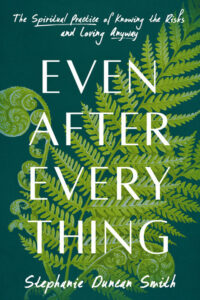This first appeared in Lit Hub’s Craft of Writing newsletter—sign up here.
Article continues after advertisement
I’ve spent my career investigating what makes an angle work—first as a publicist pitching media, then as a magazine editor screening such pitches, and finally as an editor working with nonfiction authors to craft their book concepts. My favorite question to ask authors is: what is the boldest statement you have to make? But when I first felt the itch to write a narrative nonfiction book of my own, I was stumped on the book’s “about-ness” before I had even started.
I found myself in need of my own advice, a humbling position. Now it was mine to practice and not just preach: Writing what you know is a farce. Writing into the unknown is far more interesting.
Ultimately, not knowing your book’s aboutness as you begin to write is not a problem, but a prompt.
Your angle is not your starting point, but rather a finding at which you arrive only through a diligent discovery process. This discovery process is no straight line rising to the right. Most often, it is a spiral: a slow circling, and circling, until you finally come down for a landing on your book’s aboutness.
Here are a few guiding lines that helped me in the circling.
Free yourself to create from questions rather than settled clarity. As Joan Didion said for all of us, “I write entirely to find out what I’m thinking.” In the end, writing from certainty makes for rather dull reading. What we as readers most connect with is not a flat, self-evident report, but an invitation to ride along in the writer’s discovery process, to experience the writer’s threshold moments by proxy. The churn of the questions may present itself as daunting, yet write from them, and you’re bound to be surprised by your findings. This surprise will carry to your reader.
So when you find yourself stumped, as I did, let your curiosity lead you. Let the tensions be trail markers along the way. The call of the creator is not total achievement but the ongoing work of excavation — there are always deeper layers for those who go looking. In the end, nothing will enliven your final work more than letting your discovery process show, and your surprise with it.
When you get stuck, get analog and orient your ideas spatially. The work of the writer is to look for patterns. When you bump into creative block on the screen, try using your hands. This might mean printing out your material and marking up your own marginalia. It might mean logging off your desktop and writing longhand, which studies show more fully engages both the left and right brain so that connections might. It might mean sketching your ideas on index cards to spread out on the living room floor, or making a mind map on a whiteboard or a draw pad.
We write from the prism of particularities, and this is as it should be, but like prisms, the light is meant to spill out.
For me, I had been writing in Google docs exclusively until I took a notion one day during our newborn daughter’s naptime to sketch out my themes on sticky notes. I stacked them in three rows, creating three distinct timelines. On the top row, I wrote out the timeline of the global pandemic, which was then current. On the middle row, the holy days and seasons of the Christian liturgical year, as is my spiritual tradition. And on the final row, I mapped out the timeline of my personal narrative of pregnancy loss, pregnancy after loss, and new parenthood.
Immediately, I found the thread. The juxtapositions announced themselves with startling clarity:
My first pregnancy developed during Advent, until the winter solstice—the darkest day of the year—when I lost the pregnancy. It was the week before Christmas, Advent’s week of joy. It was Easter week when we learned I was pregnant again, which meant this pregnancy had begun in unsettling parallel to the global pandemic: two vastly different sets of cells multiplying, some toward life, and some toward untold death. Months later, my daughter’s birth coincided with the peak of pandemic death in our city, as she was born nearly one year to the day after our first loss. I had flinched when the doctor first set my due date: December 22, exactly one year and one day forward from our winter solstice loss.
Those sticky notes became a creative threshold moment for me. Before them, I had simply been journaling, writing to process, unsure of where the words were taking me or what I was trying to say. But seeing those three narratives and how they might be braided together unlocked new connections. Where before there was only the tangled chaos of ideas, I could now see a constellation. This was the moment I knew this was a book.
Do the work of delineating between a work’s aboutness, and its illustrative elements. These are not to be conflated. My book draws upon the experiences of pregnancy, pregnancy loss, and new parenthood as illustrations, but it’s not about any of these things. It’s about the risks signature to love: how we discern when to go bold and when to play it safe, the contours and consequence of each choice, and how to ground oneself amid the unknowing of how any story will go. These experiences are the illustration of the heart of the work as I hope it transcends the personal narrative to speak to the wider experience of love against risk that is familiar to us all in different ways.
We write from the prism of particularities, and this is as it should be, but like prisms, the light is meant to spill out. To resonate with readers our subject matter must do the work of reaching outward into the realm of the common, where our narratives can recognize and greet each other. The best illustrations are alive with detail, but always portals speaking into the wider themes of high stakes, driving desires, search and discovery, and most all, human becoming along the way. The best illustrations catch the light, and let it shine through—from my life to yours.
Take care to give your “it” and “this” a proper name. In my editorial work, I observe the writer’s common tendency to strand their subject nouns in abstraction. First draft sentences often lead with the amorphous “It” or “This,” and mine are no exception. Yet writing that readers resonate with is animated by naming a truth, an experience, or a reality that the reader has felt but never before identified through language. Naming may be the writer’s greatest craft. On a sentence-level, bringing precision to your subject nouns make your sentences volumes more powerful, memorable, and quotable. On a structural level, naming your subject nouns can help you land the aboutness of the work.
It took me three years of writing and revising, three different working titles, and countless circling before completing my book and sealing in its aboutness. But here’s what I know now, that I only knew previously secondhand: If you’re struggling to frame what your book is about, listen to the tension and it will tell you. Walk the labyrinth of unknowing trusting that there is a center, and your circling is not aimless, but will lead you there.
_____________________________________

Even After Everything by Stephanie Duncan Smith is available now via Convergent Books.

